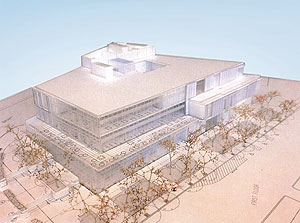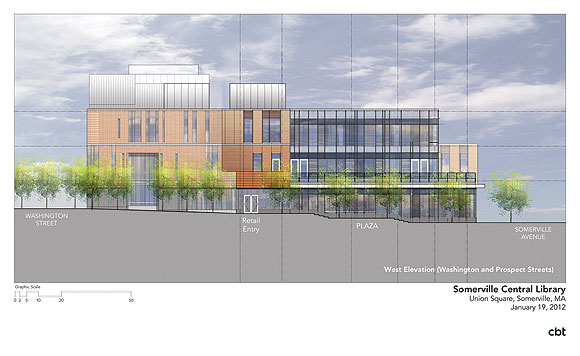
Plans for Union Square revitalization include a $45 million new library building, shown here in an architect’s rendering. – Photo courtesy of The City of Somerville
Steps forward for T station, new library
By Elizabeth Sheeran
If all goes according to plan, the Prospect Street area of Union Square will be a hotbed of public works development over the next few years.
The City of Somerville has reached a legal agreement with the state that clears the way for the planned Union Square Green Line station near the intersection of Prospect Street and Webster Avenue. That followed recent news the city had moved a step closer to winning state funding for a new Central Library on the block east of Prospect between Washington Street and Somerville Avenue.
City officials said both sites are key building blocks in the ambitious vision for a revitalized Union Square. “It’s an exciting step forward in the city’s commitment to Union Square as an evolving civic and business hub for the entire metro-Boston region.” said Mayor Joseph Curtatone.
The July 26 Memorandum of Agreement (MOA), signed by the city, the MBTA and the state department of transportation (MassDOT), literally lays the groundwork for construction of the new T-station, by spelling out the steps for acquiring the additional land needed for the project, and getting the site ready to start building.
This latest step was made possible because the Green Line Extension (GLX) project last month cleared a significant hurdle by successfully passing the federal environmental review. It also reflects a phased-in approach to the long-awaited and repeatedly delayed plan to extend the light rail line through Somerville to Medford, with a current target of 2016 to complete the main line extension as far as Washington Street and the spur line to Union Square.
Under the legally binding agreement, the city will spend around $8 million to buy two acres of land adjacent to the MBTA rail line, consisting of three parcels and including the existing Prospect Iron and Steel scrap metal business, as well as to relocate the current tenants and demolish buildings.
In return, the MBTA and MassDOT will pay for environmental cleanup and remediation, and have committed to a timetable to break ground on the new station by the spring of 2014, and have a transit station operational by early 2017.
The agreement, which also recommits the state to a number of near-term GLX project goals, was lauded by public officials, members of the business community and transit advocates, as a concrete move in the quest to bring mass-transit benefits into the heart of Somerville.
“I’m happy to see that this MOA puts legal teeth into our campaign to keep the Green Line project on the move,” said Ellin Reisner, of the Somerville Transportation Equity Partnership, an advocacy group.
“This is a great step forward for the continued advancement of Somerville’s first downtown,” said Mimi Graney of Union Square Main Streets, which promotes local business. She said the agreement between the city and state reflects “a shared goal of creating a more pedestrian-oriented, economically vital district” in Union Square.
According to the terms of the agreement, the city will grant a permanent easement to the MBTA for the station building, and a temporary easement for the pick-up and drop-off areas, and the construction staging site. But Somerville will retain long-term control over the portion of the property not covered by the station, as well as air rights for the area, which opens up the potential to bring in tax-generating transit-oriented development.
The Mayor said the city plans to explore the use of so-called District Improvement Financing, which allows the city to fund public projects with the additional taxes they help generate. “Any expenditures the city makes now will be amply rewarded by proceeds from subsequent land transfers and by tax revenues from future economic activity,” said the Mayor.
The same kind of expected long-term payback is behind the city’s proposal to build a new 70,000 square foot, $45 million state-of-the-art library building in Union Square, to replace the aging main library building on Highland Avenue, and create a public gathering place in a neighborhood which can better leverage the kind of activity a library can generate.

– Photo courtesy of The City of Somerville
The library building proposal, which recently was approved to be 40-percent funded with state grant money provided the city can fund the remainder, more than doubles the size of the current central library. It also fulfills most of a long wish-list of features asked for by residents, with better children’s and teen spaces, quiet and group study rooms, an open courtyard, and expanded community meeting space, including a 200-seat auditorium.
Library Director Maria Carpenter said modern libraries have to meet different needs, including providing access to technology, supporting lifelong learning for a more diverse population, and acting as a community gathering place, and the existing building is too small, too old, and too inflexible in the way it’s laid out. She said demand for meeting space far exceeds supply, even though the library is open 65 to 69 hours a week.
“We need even more space for people to be able to come together to meet and mingle and make connections,” said Carpenter. “Being able to bring people together to foster creativity is very much part of the vision for the public library in Somerville.”
The city hasn’t yet determined how it will fund its own 60 percent share of the library building costs, which includes the cost to purchase the land, but City Planning Director George Proakis said all options are still on the table, including some kind of public-private partnership.
A new library building would be a welcome addition to the neighborhood for local businesses, said Graney, of Union Square Main Streets. “A library attracts a thousand people a day, and we’re excited about the kind of foot traffic that can generate,” she said.
Graney said the long-term economic benefits to Union Square from either the library proposal or the Green Line station building will far exceed the short-term impact of displacing a handful of existing businesses.
She said property owners who will be displaced by the Green Line transit station have been prepared for the move for some time now, and many of the businesses no longer fit with the emerging character of Union Square. “I think you’d be hard-pressed to find anyone who thinks that a scrap iron business would be a good fit for a pedestrian-oriented business district,” said Graney.
She noted that the city has committed to ensuring that certain local businesses, most notably Ricky’s Florists, can find alternative space in the neighborhood when and if they’re displaced to build the new library building.
And Graney said any concrete news is good news when it comes to encouraging economic development. “Part of what’s been holding back development in Union Square is a sense of uncertainty,” said Graney. “Having clear commitments in place will help break through a lot of that skepticism. People who have been thinking about making a move may say, ‘now’s the time.’”
The public will get a chance to learn more about long-term plans for Union Square when the Mayor presents his detailed proposal for a Union Square Revitalization Plan at a special meeting of the Board of Aldermen next week, on Thursday, August 16.















Reader Comments